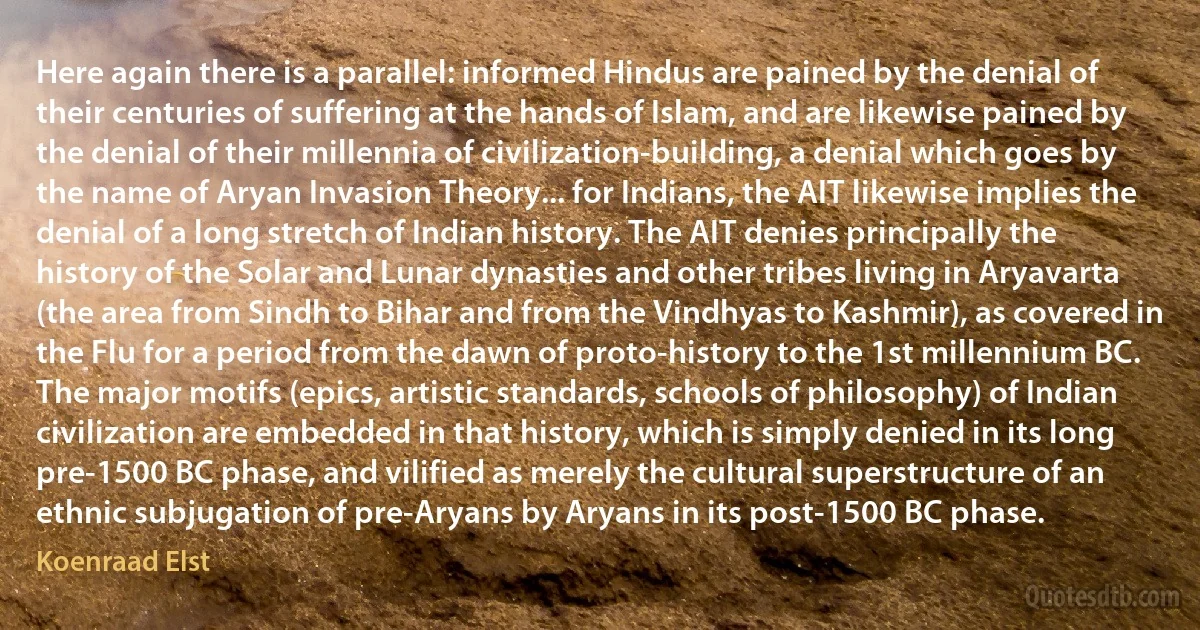
Here again there is a parallel: informed Hindus are pained by the denial of their centuries of suffering at the hands of Islam, and are likewise pained by the denial of their millennia of civilization-building, a denial which goes by the name of Aryan Invasion Theory... for Indians, the AIT likewise implies the denial of a long stretch of Indian history. The AIT denies principally the history of the Solar and Lunar dynasties and other tribes living in Aryavarta (the area from Sindh to Bihar and from the Vindhyas to Kashmir), as covered in the Flu for a period from the dawn of proto-history to the 1st millennium BC. The major motifs (epics, artistic standards, schools of philosophy) of Indian civilization are embedded in that history, which is simply denied in its long pre-1500 BC phase, and vilified as merely the cultural superstructure of an ethnic subjugation of pre-Aryans by Aryans in its post-1500 BC phase.
Koenraad ElstRelated topics
ait aryan dawn embed ethnic history islam likewise living lunar millennium name parallel solar stretch subjugation suffering superstructure flu hands biharRelated quotes
Reading conventional notions of class struggle and anti-colonialism into bin Laden, the Taliban, and radical Islam is not just solipsistic. It is nonsense. If poverty and destitution, colonialism and capitalism are animating radical Islam, explain this: In March, the Taliban went to the Afghan desert where stood great monuments of human culture, two massive Buddhas carved out of a cliff. At first, Taliban soldiers tried artillery. The 1,500-year-old masterpieces proved too hardy. The Taliban had to resort to dynamite. They blew the statues to bits, then slaughtered 100 cows in atonement-for having taken so long to finish the job. Buddhism is hardly a representative of the West. It is hardly a cause of poverty and destitution. It is hardly a symbol of colonialism. No. The statues represented two things: an alternative faith and a great work of civilization. To the Taliban, the presence of both was intolerable.

Charles Krauthammer
This way, Godse (born 1910) exacted ‘punishment' for Gandhi's alleged pro-Muslim policies. These were particularly his acceptance in June 1947 of the plan to partition India into a secular state, retaining the name India and a Muslim state called Pakistan; and more immediately his fast, earlier in January 1948, on behalf of the safety of the Delhi Muslims threatened by angry Hindu refugees pouring in from Pakistan, and in support of Pakistan's demand that India pay them ₹550 million as their share from the treasury of British India. Under protest, the Indian Government had given in to the latter demand because of Gandhi's pressure, and in spite of the presence of Pakistani invasion troops on Indian territory in Kashmir. Surely this was the first time in history that a country deliberately financed its battlefield opponent, and not everyone was pleased with this display of Gandhian values.

Koenraad Elst
Throughout the whole range of Urdu literature in its first phase... the atmosphere of this literature is provokingly un-Indian - it is that of Persia. Early Urdu poets never so much as mention the great physical features of India - its Himalayas, its rivers like the Ganges, the Jamuna, the Sindhu, the Godavari, etc; but of course mountains and streams of Persia, and rivers of Central Asia are always there. Indian flowers, Indian plants are unknown; only Persian flowers and plants which the poet could see only in a garden. There was a deliberate shutting of the eye to everything Indian, to everything not mentioned or treated in Persian poetry... A language and literature which came to base itself upon an ideology which denied on the Indian soil the very existence of India and Indian culture, could not but be met with a challenge from some of the Indian adherents of their national culture; and that challenge was in the form of highly Sanskritized Hindi'.

Suniti Kumar Chatterji
Islam is one of the world's great religions. Let me be explicit about what I, as a historian of Islam who is not a Muslim, mean by that. Islam has brought comfort and peace of mind to countless millions of men and women. It has given dignity and meaning to drab and impoverished lives. It has taught people of different races to live in brotherhood and people of different creeds to live side by side in reasonable tolerance. It inspired a great civilization in which others besides Muslims lived creative and useful lives and which, by its achievement, enriched the whole world. But Islam, like other religions, has also known periods when it inspired in some of its followers a mood of hatred and violence. It is our misfortune that part, though by no means all or even most, of the Muslim world is now going through such a period, and that much, though again not all, of that hatred is directed against us.

Bernard Lewis
Summarizing the evidence relating to the slaughter of the Buddhist Monks perpetrated by the Musalman General in the course of his invasion of Bihar in 1197 AD, Mr. Vincent Smith says, "....Great quantities of plunder were obtained, and the slaughter of the 'shaven headed Brahmans', that is to say the Buddhist monks, was so thoroughly completed, that when the victor sought for someone capable of explaining the contents of the books in the libraries of the monasteries, not a living man could be found who was able to read them. 'It was discovered,' we are told, 'that the whole of that fortress and city was a college, and in the Hindi tongue they call a college Bihar.' " Such was the slaughter of the Buddhist priesthood perpetrated by the Islamic invaders. The axe was struck at the very root. For by killing the Buddhist priesthood, Islam killed Buddhism. This was the greatest disaster that befell the religion of the Buddha in India.

Bhimrao Ramji Ambedkar
